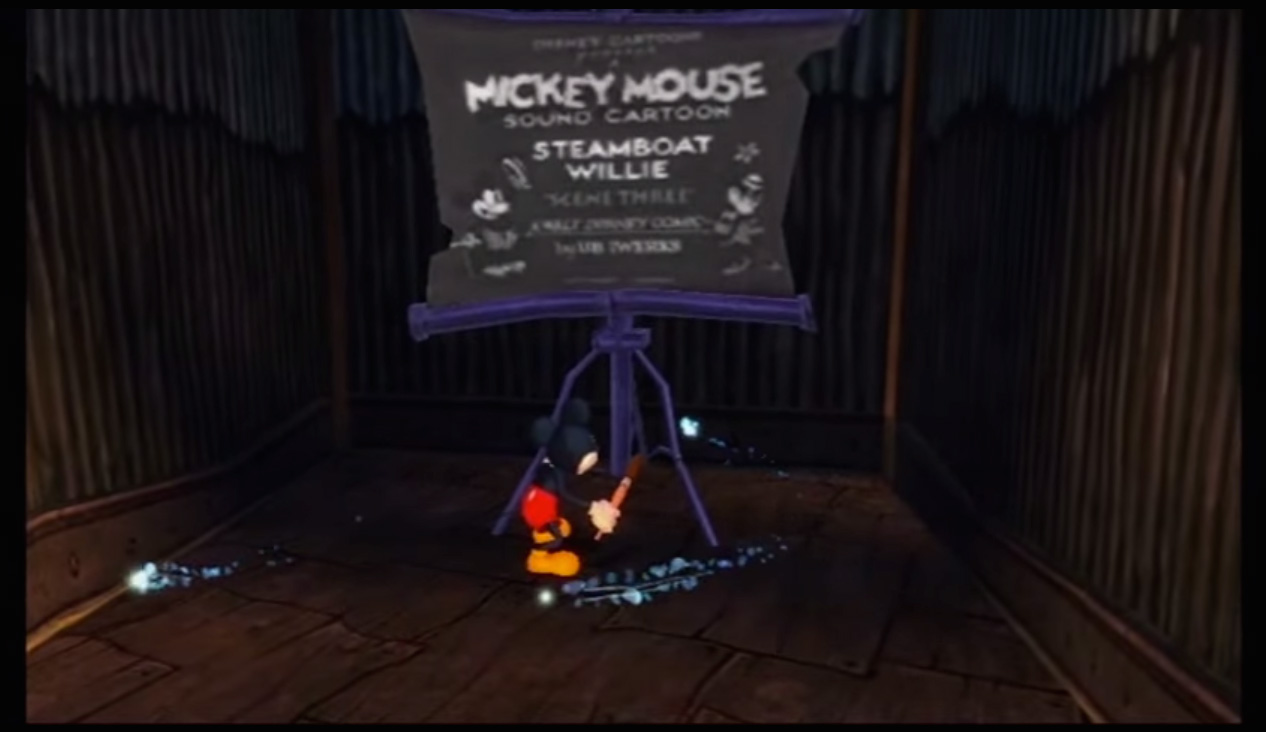Cartoon Wasteland: Remediating and Recommodifying Archival Media in Disney’s Epic Mickey
Skip other details (including permanent urls, DOI, citation information): This work is licensed under a Creative Commons Attribution-NonCommercial-NoDerivatives 3.0 License. Please contact [email protected] to use this work in a way not covered by the license.
For more information, read Michigan Publishing's access and usage policy.
Epic Digitextuality
From a ludological perspective, the convergence of old- and new-media texts that underlies Epic Mickey’s conceptual makeup also informs the game’s formal/aesthetic design and game mechanics in three key ways. First, in much the same way that the game’s characters and settings are plucked from the Disney archives and remediated in a new media text, Epic Mickey’s game mechanics also deploy the aesthetic apparatuses and materials of traditional animation in a digital game environment. In other words, using the Wii controllers, the player wields a paintbrush tool and paint or thinner to virtually “paint in 3-D” on the digital canvas of the game interface. Second, the game negotiates “old” and “new” gameplay styles (side-scrolling-platform and third-person-shooter modes of play, respectively) and aesthetic codes (3-D rendered environments and 2-D “filmic” levels), combining 3-D animated platform levels that deploy the haptic, biofeedback play elements of the Wii console, with 2-D side-scrolling levels that require the player to move in a fixed lateral trajectory. Crucially, these side-scrolling levels are also aesthetically differentiated from Cartoon Wasteland’s volumetric worlds and are self-consciously coded as “filmic” spaces. Each of these levels is directly inspired by 1920s–1950s Disney animations, such as Steamboat Willie (dirs. Ub Iwerks and Walt Disney, 1928) and Alpine Climbers (dir. David Hand, 1933) among many others.
Visually, their flickering, grainy look and sprocket–holed filmstrip borders conjure the materiality of celluloid (fig. 3). Sonically, these levels feature a sound loop that evokes the noises of a film projector, and many of them also reference classic Disney films’ scores.[23] Moreover, to gain entrance into these levels, the player must jump in and out of projector screen “portals” that quite explicitly mark the transition between the game’s 2-D filmic and 3-D volumetric surfaces (fig. 4). Put differently, situating Epic Mickey’s remediated properties along Bolter and Grusin’s spectrum of remediation (“based on the degree of perceived competition or rivalry between the new media and the old”), the game falls into the category of “electronic remediations [that] seem[s] to want to emphasize the difference [between the old and the new] rather than erase it, thus engendering a form of “hypermediacy.”[24] Indeed, Epic Mickey is a hypermediated text on numerous levels: the game remediates old Disney characters, theme parks, and other properties and deploys the formal and aesthetic codes of celluloid film, hand-drawn concept art, and 2-D side-scrolling platform games.
Third, from a production standpoint, the Junction Point team’s creative process can also be understood as a remediation practice. Spector details that, in order to maintain a sense of historical and aesthetic continuity in the digital animation of the game’s archival properties, the animators worked from “clips from the real cartoons and played and composited our characters into those sequences . . . so that they overlaid each other, so that you could see both at the same time.” In other words, the animators digitally composited their 3-D character models directly onto their analog antecedents and worked from this palimpsestic text to simulate the “squash and stretch” aesthetic of Disney’s traditional hand-drawn animation style, using computer-generated animation technology.
Given the game’s negotiation of old and new media, of polyvalent play modalities and aesthetic codes, it is instructive to read Epic Mickey’s aesthetic and economic “reanimation” of archival media within the framework of digitextuality. Everett describes digitextuality as a process by which “new media technologies make meaning not only by building a new text through absorption and transformation of other texts, but by embedding the entirety of texts (analog and digital) seamlessly within the new.”[25] In much the same way, Epic Mickey makes meaning through its negotiation of Wasteland’s digital environments and interstitial “filmic” spaces. In effect, it works through a new media environment to introduce the player-consumer to a wide range of “old” remediated Disney artifacts woven into the game’s digital universe. Critically, however, this remediation of analog content is more than a simple redeployment of other forms of Disney media.
Following Everett’s argument that “the usefulness of articulating new-media practices’ imbrication in old-media precedents is not to proffer a reduction of the former to a mere rearticulation of the latter,” mapping Epic Mickey’s digitextuality involves interrogating how “cybernetic tools” “recycle, recode, and redeploy classical-media modes and codes to heighten contemporary media users’ and consumers’ affective responses to new-media functions.”[26] For Everett, digitextuality lays bare the “interstices between our nostalgic analog dreams and discomfiting digital realities . . . in our congealing technocracy.”[27] In other words, digitextual practices must be situated within our increasingly digitized and hypermediated context. Analog media is therefore framed as a means by which to counteract the rapidity with which media technologies are now advancing, mitigating the effects of digitization and technological change by allowing for a retreat into a “nostalgic analog dream.”[28]
In relation to Epic Mickey, I would add a reciprocal trajectory to Everett’s model. Inasmuch as the game’s use of 2-D animation might render its digital aesthetics more affectively resonant for media users more familiar with “classical-media modes and codes,” I would also argue that this dynamic exchange operates in the inverse direction in equal measure. That is, remediating archival media and characters—and specifically squash-and-stretch cartoon aesthetics that are very much at odds with computer animation’s 3-D volumetrics—within a new-media text potentially heightens the affective appeal of this “old” media for users and consumers whose media interactions might well be largely circumscribed to new-media environments (cell phones’ digital displays, computer screens, tablet devices, and so on). Epic Mickey’s digitextuality is thus not merely a reflection of Disney’s relentless reissuing cycles but an aesthetic strategy that serves numerous economic and ideological functions. The dialogical relationship between old and new media operates on a number of levels: the game recuperates out-of-circulation media and remediates its unfamiliar aesthetic codes by incorporating them into a digital game design and, simultaneously, engages in a form of intertextual storytelling and marketing.
Finally, in addition to repurposing traditional animation’s fundamental tools and techniques (in an era in which digital animation vastly overshadows hand-drawn animation’s box-office appeal), Epic Mickey’s haptic paint/thinner functions can also be understood in relation to Everett’s notion of “click theory,” one of the underlying components of digitextuality. Everett proposes:
digital media technologies are distinguished from their analog counterparts through a sort of phenomenological “click fetish” and concomitant lure of sensory plenitude effect, presumably available simply, instantaneously, and pleasurably with any one of several clicking apparatuses . . . such as the computer mouse, video game joystick, wireless cell phone with Internet connectivity . . . [29]
Read through the lens of click theory, Epic Mickey’s digitextual codes might then be understood as a strategy for intensifying player’s phenomenological connection with the game’s digital interface. By allowing the player to paint and thin with the Wii joystick—to create and erase the digital environment with her own body—the game bridges the player’s physical-corporeal space and the game’s virtual space and thereby, through what Everett terms a new form of “kinesics,” calls forth “new modalities of corporeal interactive plenitude.”[30]




